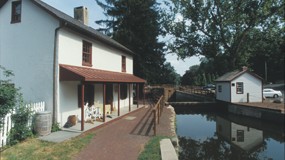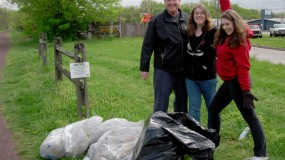MESSAGE FROM BRETT WEBBER

President of the FODC Board
With spring finally upon us, many of us are drawn once more to explore the Delaware Canal Towpath’s 58.9 miles from Easton to Bristol. Along the canal we observe the signs of the new season’s changes in the landscape, both flora and fauna. As we take in all that the towpath and the Delaware Canal State Park have to offer, let us remind ourselves that these 830 acres are part of the Commonwealth’s more than 300,000 acres of public space.
This land is our land, and it is worth honoring, preserving, protecting and sustaining. As Pennsylvania taxpayers, we support our historic and natural heritage directly with our tax dollars. We should be proud that we’re able to share this great public resource with our families and friends and visitors from around the country and around the world—for little or no access fees in most cases. This land, held in public trust, is also a meaningful part of our economy. In 2023, the outdoor recreation industry contributed $17 billion to the state’s economy, which is about 2% of the state’s gross domestic product.
In addition, the outdoor recreation industry supports over 168,000 jobs in Pennsylvania.1 Preserving, maintaining and enhancing this asset is not only a moral imperative for us as citizen stewards, but one of compelling economic necessity. Annually, Pennsylvania’s state parks receive over 36 million visitors—an enormous boost to our local small businesses, restaurants and lodging options.2 In addition to our state parks, Pennsylvania is also home to 19 national parks and historic sites. Together, they welcome over 7.3 million visitors annually and contribute more than $662 million in economic benefits.3
Across our state and country, park managers, rangers and staff perform a great service, of- ten working at sites that are understaffed and struggling to address the impacts of climate change and increasing use. We must make clear to government officials that while we understand that there is always room for greater efficiency, there are also significant reasons for maintaining funding for work done in support of park management, conservation and public safety. These are pillars of a significant part of our state’s economy.
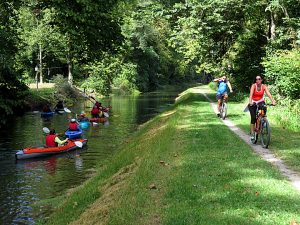
Now, more than ever, it is important to communicate how we value our natural spaces. The parks need us to stand up for their protection, preservation and careful management. I encourage you to contact your state legislator and reinforce the importance of our state parks. And I urge you to reach out to your congressional representative, explaining the need for fully operational national parks and other public spaces. As we seek causes that bring us together, public lands should always remain something that we treasure and protect for each other and for future generations.
Beyond sending letters and emails, there’s another way to demonstrate your support for our parks, especially the Delaware Canal. Please join me and fellow members of the Friends for our Annual Canal Clean Up Day on April 12th. Together, let’s do our part in caring for our canal and by example, demonstrate a productive and positive way to take a stand for our public land.
Brett Webber President of the Board of Directors
Friends of the Delaware Canal
PARK MANAGER’S REPORT
By Kelsey Hansen, Assistant Park Manager
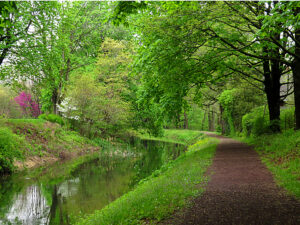 WELCOME to spring! Southeastern Pennsylvania will still be dealing with some ups and downs with the temperatures, but otherwise, hearing the birds chirping and feeling slightly warmer air than previous months helps to bring some refreshed hope to the heart.
WELCOME to spring! Southeastern Pennsylvania will still be dealing with some ups and downs with the temperatures, but otherwise, hearing the birds chirping and feeling slightly warmer air than previous months helps to bring some refreshed hope to the heart.
As always, with spring comes those changing precipitation patterns. It seems nowadays that our weather is boom or bust—we receive intense rain all at once, or we receive a scant amount. The park is wary of the intensive rainfall. If weather forecast services are anticipating half an inch total or higher, we have to start taking action with the canal—which of course depends on how full it is to begin with.
When a heavy rain is expected, we have several things to consider: tributaries bringing water to the canal, development or impervious surfaces upstream of the canal and general runoff. Since the canal is not a flood control system, we sometimes must let out water from the canal to reduce the possibility of it overtopping during a heavy rainstorm.
Remember, the park does not purposely keep the water levels low for any reason besides projects that require dewatering or imminent heavy rain. We understand that during the spring, this can potentially affect the number of trout in the canal for recreational fishing. We keep that in mind too when decreasing the water levels. It’s a balancing act, and I wouldn’t call it simple. We do the best we can to keep fish in the canal and not to cause flooding to our neighbors.
Our high-profile projects, the Lumberville aqueduct and the High Falls sub-canal culvert, began construction work in January. Coming up this year is Phase 3 of our bridge replacement project for 12 structures. Phase 3 consists of Berm Lane bridge, Canal Road South bridge, Island Road bridge, Mechanic Street bridge and Rabbit Run culvert. These structures have been identified
as needing replacement, and this is an effort by the state to be proactive in having them replaced before they have to be completely shut down due to safety reasons. We hope to have them out to bid this fall; nothing is set in stone.
Spring also means the return of our seasonal staff members who went on leave in November. We look forward to having them back, and I’m sure all who access the park do too. Our maintenance staff plays an integral part in how this park complex runs as an operation. Without their helpful hands during the busiest part of the year, our park would not be as clean or well maintained. They help to keep the bathrooms clean over the busy summer weekends, do trail repair and tree removal and assist with picking up litter that’s made its way to the canal.
Have a good spring and try to enjoy the changing weather and all the spring flowers.
SOURCEs: 1,2 PA.GOV, 3. NPS.GOV
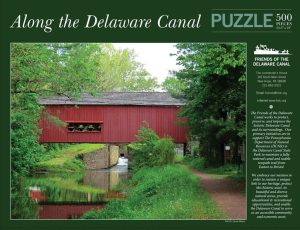
Just in time for Mother’s Day!
Our new, limited-edition puzzle has arrived. This high-quality, American-made puzzle features an enchanting image of the Uhlerstown Covered Bridge, an iconic landmark along the Delaware Canal.
The hamlet of Uhlerstown is one of the true historic gems along the towpath. Once a prosperous settlement built mainly around the canal and its operations, itis now considered one of the best-preserved canal hamlets in America.
The Uhlerstown Covered Bridge is the only covered bridge over the Delaware Canal. Originally built in the 1830s, this lattice-truss bridge effectively utilized the limited lumber resources available at the time. Ithiel Town, an engineer in 1820, patented the bridge design. It was constructed not with heavy timbers but with planks and wooden pegs, providing an economical and easy-to-construct solution for spanning the canal.
The 500-piece puzzles are available for $25.00 and can be purchased at the Locktender’s House in New Hope. We also offer shipping to any address of your choice for an additional postage fee.
GOT A GREEN THUMB? LET’S TALK
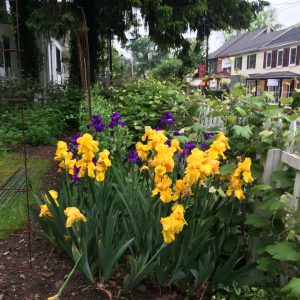
The Locktender’s House in New Hope has a kitchen garden similar to one that fed the family in residence. Friends of the Delaware Canal volunteers have worked to repair and paint the fence and improve the stone path, but the garden itself needs some TLC.
If you would like to lend a hand and a green thumb, too, let us know. We are looking for volunteers who can commit time bi-weekly to help bring this garden to life. Call the Friends at 215-862-2021 or email us at Friends@fodc.org.
Photo: Yellow Iris in the Locktender’s House Garden
The Legacy of the Delaware Canal Lives On
The construction and operation of the Delaware Canal brought prosperity to the region, with hamlets growing into centers of milling and manufacturing. During the canal’s active years, many locals were employed, enabling them to elevate the living standards of their families.
The surnames of these canallers can be found today with many descendants still living in the Delaware River Valley. And, many of
their ancestors are buried in nearby historic cemeteries.
Judy Nygard, a volunteer researcher, writer, and tour guide for the Lower Tinicum Union Cemetery, followed the life of one of these canallers, Henry Gulden, and chronicled the changing landscape in which he lived.
HENRY GULDEN, CANAL BOATMAN AND CIVIL WAR VETERAN IN TINICUM TOWNSHIP
From 1850-1870 the Delaware Canal became increasingly essential to Tinicum Township, situated near the middle of the canal. Although most township residents farmed for a living, the canal became an important source of work for others. Tinicum was a center for building canal boats as well as home to boatmen, boat builders, lock tenders others working on the canal. One boatman who spent his adult life on the canal was Henry Gulden (1833-1876), a Civil War veteran.
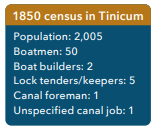 Working on the canal was the third most popular occupation in Tinicum after farming and labor jobs. The township’s 1850 census lists 59 canal workers. Other residents worked for the canal
Working on the canal was the third most popular occupation in Tinicum after farming and labor jobs. The township’s 1850 census lists 59 canal workers. Other residents worked for the canal
indirectly. Numerous sawyers, carpenters, stone masons and laborers built and repaired boats, bridges and locks. Local farmers raised mules to pull boats, and residents shipped products on them. Gulden was a successful family man and boatman. By 1860, Gulden and his wife Mary Ann Heaney had daughters Euphemia and Salome and son William. The couple welcomed seven more children—Joseph, Mary, Annie and Harvey in the 1860s and Eastburn, Mahlon, Stephen, and George Vincent in the 1870s. His real estate was valued at $1,000 and his personal estate at $400 in the 1860 census. By the 1870 census, his real estate was worth $700 and personal property $1,000.
Other township residents also found the canal a source of success. By 1860 the number of Tinicum boatmen and boat builders had nearly doubled. A total of 102 Tinicum residents worked directly on the canal with many others providing indirect services and labor. Canal jobs remained the third most popular occupation category.
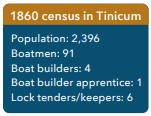 On November 1, 1862, Gulden joined Company F of the regular Pennsylvania 174th Infantry with others from the township and Bucks County. After postings in Washington, D.C., Virginia, and North Carolina, the 174th spent six months in South Carolina. After nine months in the infantry, Gulden was mustered out on August 7, 1863—two weeks before his 30th birthday.
On November 1, 1862, Gulden joined Company F of the regular Pennsylvania 174th Infantry with others from the township and Bucks County. After postings in Washington, D.C., Virginia, and North Carolina, the 174th spent six months in South Carolina. After nine months in the infantry, Gulden was mustered out on August 7, 1863—two weeks before his 30th birthday.
Returning to his former life as a boatman, he would have recognized neighbors whom he had worked with since 1850. Gulden probably also noticed new faces in the first few years after his return. Many young sons of Tinicum farmers sought work on boats, along with other men from Pennsylvania, New Jersey and Europe.
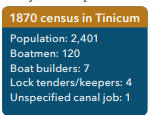 The 1870 census also reveals an important shift. For the first time, the number of canal workers surpassed the number of general laborers in the township. Canal work in Tinicum was now the
The 1870 census also reveals an important shift. For the first time, the number of canal workers surpassed the number of general laborers in the township. Canal work in Tinicum was now the
second most popular job after farming.
Another major change in Gulden’s work life was one that he noticed more quickly: additional federal taxes! He had regularly paid state and county taxes since the 1850s. Canal boat operators were levied on their total receipts. On January 1, 1865, Gulden was assessed for his success on the canal. He submitted $38.48 (about $1,500 today) on his total earnings of $1,219 (about $46,000 today). Henry was the eighth highest-earning boatman of 94 in this federal tax district.
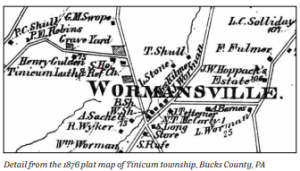 When Gulden passed away in 1876, church records note “George Henry Gulden aged 42 yrs 1 m[onth]” followed by the comment “a fine man.” He was buried in Swope graveyard located to the right of his house at the intersection of two roads. The graves of his mother, two young sons and daughter Salome lie next to his. Mary Ann collected her husband’s Civil War pension from 1881 until her death in 1935 at age 98. She was buried in the graveyard at St. John the Baptist Catholic Church in Haycock township along with six children.
When Gulden passed away in 1876, church records note “George Henry Gulden aged 42 yrs 1 m[onth]” followed by the comment “a fine man.” He was buried in Swope graveyard located to the right of his house at the intersection of two roads. The graves of his mother, two young sons and daughter Salome lie next to his. Mary Ann collected her husband’s Civil War pension from 1881 until her death in 1935 at age 98. She was buried in the graveyard at St. John the Baptist Catholic Church in Haycock township along with six children.
When Gulden was working as a boatman from 1850-1876, the Delaware Canal became increasingly important for residents of Tinicum as a place of employment. But by the time his last surviving child—Mahlon—died in 1948, the Canal had seen its last paying boat over a decade earlier on October 17, 1931.
About the Author: Judy Nygard is a volunteer researcher, writer and tour guide for the Lower Tinicum Union Cemetery. The 501(c)(3) non-profit, incorporated in 1993, maintains four historic
graveyards (Hillpot, Fox, Swope, Union) in Tinicum Township.
Sources: This article includes some online sources as well as physical reference material from local cemeteries and research from Ancestry.com. For a full list, you can view them below.
“174th Regiment Pennsylvania Volunteers. Company F.” PA-roots. www.pa-roots.com/
pacw/infantry/174th/174thcof.html
“174th Pennsylvania Infantry Regiment.” The Civil War in the East. www.civilwarintheast.com
“A Brief History of the Delaware Canal.” Friends of the Delaware Canal. www.fodc.org
“List of Confirmands 1849.” “Burials 1876.” Christ Lutheran Church, Pipersville, PA
“List of Burials in Swope Graveyard.” Lower Tinicum Union Cemetery, Inc., Pipersville, PA
“Tinicum, Bucks County, Pennsylvania.” Find a Grave. www.findagrave.com
Through Ancestry.com:
1890 Veterans Schedules of the U.S. Federal Census
American Civil War Regiments, 1861-1866
Bucks County, PA, Tax Records, 1782-1860 (Henry Gulden 1853-1860)
Civil War Soldiers, 1861-65
Civil War Soldier Records and Profiles, 1861-1865
Civil War Pension Index: General Index to Pension Files, 1861-1934
Pennsylvania, Wills and Probate Records, 1683-1993 (Bucks County Orphans Court 1876)
Pennsylvania, Veterans Burial Cards, 1777-2012
“Bucks County, Pennsylvania.” Indexed County Land Ownership Maps, 1860-1918 (Specifically, Scott, J.D. Atlas of Bucks County. Philadelphia: 1876)
Upper Tinicum Lutheran Church records for baptisms, communion 1859-1876, Upper Black Eddy, PA
U.S. Federal Censuses, 1840, 1850, 1860, 1870
U.S. I.R.S. Tax Assessment List, 1865
At the Board Table
TWO NEW BOARD MEMBERS TO SUPPORT THE FRIENDS’ MISSION
This year, we welcomed two new board members: Michele Becci and Bob Margadonna.
Michele Becci
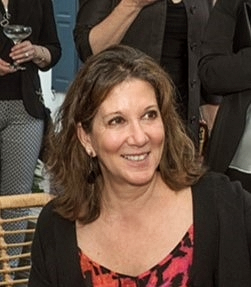
Michele Becci grew up in Phillipsburg, NJ, and frequently visited New Hope for ice cream and walks on the canal with her grandfather as a child. Her childhood dream was to ‘live in New Hope and own a Monte Carlo.’ While she never got the Monte Carlo (thankfully), she now lives in New Hope, in the historic Locktender’s House at what was Lock 10. Since 2016, Jay (her partner) and Michele have been lovingly restoring the home, and both are passionate about preserving the history and legacy of the Delaware Canal and New Hope.
Professionally, Michele worked in the science and technology sector for over 35 years, leading global strategy and sales teams in the clinical trials software industry. She spent most of her career
at Oracle Corporation, followed by Medidata (now part of Dassault Systèmes) in NYC.
Michele left corporate America in 2022 to follow her passion for all things Italian. Today, she focuses on cooking, travel writing, and photography in support of her Italian website, Our Italian
Table. She is fortunate to call Montalcino, Tuscany, her second home, where she has an apartment just steps from the main piazza. In addition, Michele serves as a councilwoman on New Hope Borough Council.
Bob Margadonna

Since 2018, Bob Margadonna has resided in the Borough of New Hope, PA with his wife, two sons and dog. Most recently, he served four years on the New Hope Borough Shade Tree Commission,
where he actively pursued grants and partnerships with the Pennsylvania Horticulture Society (PHS) and the Riverwoods Homeowners Association, resulting in the planting of dozens of new trees acquired from PHS to help offset the devastation caused by the emerald ash borer.
Bob has a longstanding interest in conservation and is committed to preserving and enhancing the natural areas that enrich our communities along the Delaware River. He currently serves as a Canal Tender and notably, has been an active member and strong advocate for New Hope for Our Canal, which seeks to ensure funding is in place for full-year operation of the pump at Centre Bridge that supplies water from the Delaware River, ensuring the canal is fully watered from Solebury through New Hope Borough.
Professionally, for the last 15 years Bob has been employed at Merck as Commercial Lead for Scientific Strategy and Engagement on the Hospital Antibacterial Marketing Team.
In his spare time, Bob can frequently be found bicycling with friends on the towpath and visiting the many communities along the Delaware River. In his new role as Board Member, Bob’s primary focus will be the Fundraising and Membership Committees.
GORDON HEISLER RETIRES AS A FRIENDS’ BOARD MEMBER
Gordon Heisler has been a very active member of the Friends for over 15 years and a board member since 2020. However, he decided that while he will continue to be a committed supporter, 2024 would be his last year on the board. Gordon’s contributions can be seen throughout Delaware Canal State Park. He used his time and talent on projects ranging from bridge painting to 911 bench installation. Gordon even tackled restoring the garden fence at the Locktender’s House with the help of fellow board member Pete Rosswaag and volunteer Jay Freeo.
Along with his construction skills, Gordon is an avid cyclist and a kayak enthusiast who willingly led bike rides and boating adventures along the canal. While we will miss his contribution as a
board member, you can’t keep a good man down. Gordon plans to continue assisting with events and outings throughout the year.
Other Board News
At the January Board Meeting, we also elected our officers for 2025. They include: Brett Webber (President), Laure Duval (Vice President), Jack Torres (Secretary), Matt Emanuel (Treasurer)
In addition, several board members, including Joan Fullerton, Jack Torres, and Ken Standig, were elected to a new two-year term.
Exploring and Accessing the Delaware Canal Towpath
The towpath is nearly 60 miles long and much of it runs through private property. For those unfamiliar with the area, gaining access to the towpath may not be apparent. You know the location of the towpath, and you can often see it from the road, but how do you actually get on the trail?
There are several tried-and-true starting points that we often recommend based on the availability of parking, restrooms and nearby eateries. Below is a list of access points with parking spots,
restrooms and other amenities noted.
Exploring the canal’s northern section
• Forks of the Delaware Park Trailhead, MM 58.9: Picnic area, bike repair station
• Wy-Hit-Tuk Park, MM 56: Seasonal restroom, picnic area
• Theodore Roosevelt Recreation Area, MM 51.1: Kayak launch, restrooms, picnic area
• PA Fish and Boating Access Area, MM 49.4: Picnic area
• Ringing Rocks Trailhead, MM 44.9
Exploring the canal’s central section
• Lodi Hill Delaware Canal State Park Office, MM 41.7: Restroom, picnic area
• Giving Pond Recreation Area, MM 40.8: Seasonal restroom, indirect access to the towpath
• Tinicum Park, MM 38.6: Restroom, disc golf, playground, picnic area
• Virginia Forrest Recreation Area, MM 28.9: Restrooms, picnic area
• Solebury Canal Park, MM 25.7: Portage bikes over staircase to towpath
Exploring the canal’s southern section
• Washington Crossing Park (northern entrance), MM 22.2: Restrooms, picnic area, bike repair station
• Washington Crossing Park (southern parking area), MM 17.8: Restrooms, picnic area
• Woodside Road (Park and Ride Lot), MM 15.2: Restrooms, bike repair station
• Black Rock Road, MM 12.2: Restrooms, picnic area
• Levittown Shopping Center, MM 4.3: Restroom access
• Bristol Riverfront Park, Bristol PA
A gem in our in own backyard
There is much to see and explore along the Delaware Canal. To ensure you have the best experience, check the FODC.org website for any construction related towpath closures or call our office at
215-862-2021 for updates. We recommend you spend some time mapping out where you want to explore and use our Landmark and Mileage chart to help guide the way. You can find the Landmark and Mileage chart on our website at fodc.org/about-the-canal/ landmarks-and-mileage/
